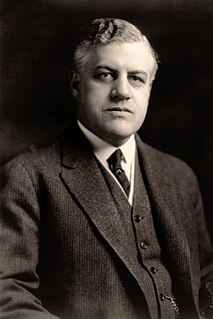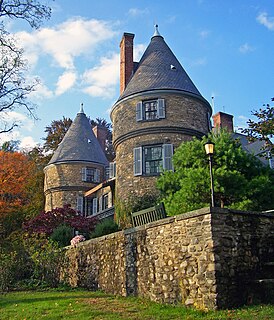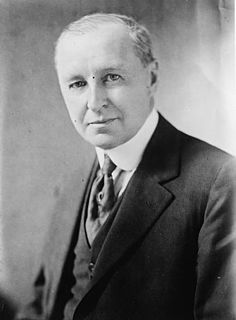
Alexander Mitchell Palmer, best known as A. Mitchell Palmer, was United States Attorney General from 1919 to 1921. He is best known for overseeing the Palmer Raids during the Red Scare of 1919–20.

James Albertus Tawney was an American blacksmith, machinist and U.S. politician and a member of the United States House of Representatives from Minnesota. He was the first House Majority Whip, holding that position from 1899 to 1905.
The Pinchot–Ballinger controversy, also known as the "Ballinger Affair", was a dispute between U.S. Forest Service Chief Gifford Pinchot and U.S. Secretary of the Interior Richard A. Ballinger that contributed to the split of the Republican Party before the 1912 presidential election and helped to define the U.S. conservation movement in the early 20th century.

John Sydney Fine was an American lawyer, judge, and politician. A Republican, he served as the 35th Governor of Pennsylvania from 1951 to 1955.

The Mason-Dixon Trail is a 195.9-mile (315.3 km), blue-blazed footpath that connects the Appalachian Trail with the Brandywine Trail, passing through Gifford Pinchot State Park and White Clay Creek Preserve in Pennsylvania and White Clay Creek State Park in Delaware. About 30 per cent of the "trail" is a route marked along public roads; the remainder is actual trail.

The 2008 congressional elections in Arizona were held on November 4, 2008, to determine who would represent the state of Arizona in the United States House of Representatives, coinciding with the presidential election. Representatives are elected for two-year terms; those elected would serve in the 111th Congress from January 4, 2009, until January 3, 2011.

Grey Towers National Historic Site, also known as Gifford Pinchot House or The Pinchot Institute, is located just off US 6 west of Milford, Pennsylvania, in Dingman Township. It is the ancestral home of Gifford Pinchot, first director of the United States Forest Service (USFS) and twice elected governor of Pennsylvania.

The 1926 United States Senate election in Pennsylvania was held on November 2, 1926. Incumbent Republican George W. Pepper, who was appointed following the death of Boies Penrose, was defeated for re-nomination by William Scott Vare. Vare won the election, defeating Democratic opponent William Bauchop Wilson. He was not permitted to assume office, however, until an investigation was conducted into possible election fraud and corruption. Vare was ultimately unseated in December 1929 by the Senate, following charges of corruption.

The 1934 United States Senate election in Pennsylvania was held on November 6, 1934. Incumbent Republican U.S. Senator David A. Reed sought re-election to another term, but was defeated by Democratic nominee Joseph F. Guffey.

The Pennsylvania gubernatorial election of 1922 occurred on November 7, 1922. Incumbent Republican governor William Sproul was not a candidate for re-election. Republican candidate Gifford Pinchot defeated Democratic candidate John A. McSparran to become Governor of Pennsylvania.

The Pennsylvania gubernatorial election of 1926 occurred on November 2, 1926. Incumbent Republican governor Gifford Pinchot was not a candidate for re-election. Republican candidate John Fisher defeated Democratic candidate Eugene C. Bonniwell to become Governor of Pennsylvania.

The Pennsylvania gubernatorial election of 1930 occurred on November 4, 1930. Incumbent Republican governor John Stuchell Fisher was not a candidate for re-election. Republican candidate and former governor Gifford Pinchot defeated Democratic candidate John M. Hemphill to win a second, non-consecutive term as Governor of Pennsylvania.

The Pennsylvania gubernatorial election of 1934 occurred on November 6, 1934. Incumbent Republican governor Gifford Pinchot was not a candidate for re-election. Democratic candidate George Howard Earle III defeated Republican candidate William A. Schnader to become Governor of Pennsylvania. This was the first Pennsylvania gubernatorial election won by the Democratic Party since 1890.

Francis Shunk Brown was an American lawyer from Pennsylvania who served one term as Pennsylvania state Attorney General from 1915 to 1919 and ran unsuccessfully in the Republican primary for Governor in 1930.

George Elias Alter was a Pennsylvania lawyer and politician, who served a term as state Attorney General.
The Pinchot South Sea Expedition was a 1929 zoological expedition to the Caribbean and South Pacific led and financed by Gifford Pinchot.
Ruth Pickering Pinchot was an American writer, critic, and activist.


















